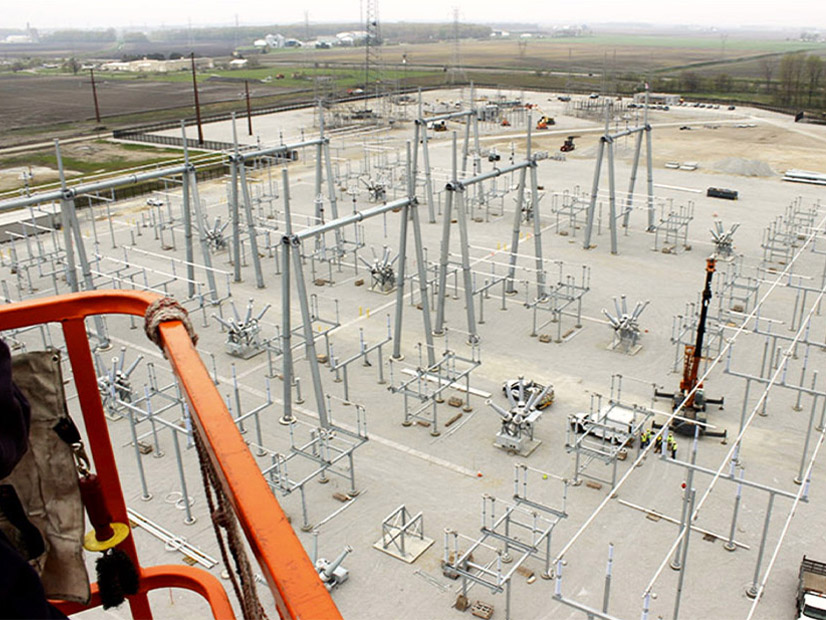A bevy of consumer, clean energy and environmental advocates have joined state regulators in appealing to MISO and PJM to undertake more comprehensive interregional transmission planning.
Clean energy groups and consumer advocates have banded together to send separate letters to MISO and PJM’s Interregional Planning Stakeholder Advisory Committee (IPSAC) to request a new approach to interregional planning.
A collection of 13 environmental groups said there’s an urgent need for more transmission bridging MISO and PJM “from a reliability, economic and public policy perspective.” The letter was penned by the Rocky Mountain Institute and signed by the Union of Concerned Scientists, Advanced Energy United, Clean Grid Alliance, Sierra Club, Environmental Law and Policy Center, Natural Resources Defense Council, Americans for a Clean Energy Grid and Earthjustice, among others.
“Despite the continued demonstration of need for enhanced interregional transmission between PJM and MISO, total buildout of interregional transmission continues to lag this demonstrated need,” the organizations said.
Consumer advocates, including Michigan’s and Illinois’ attorneys general; the Citizens Utility Boards of Michigan, Illinois and Minnesota; the Indiana Office of Utility Consumer Counselor; and the New Jersey Division of Rate Counsel struck a similar tone in their letter.
“Transmission planning is more cost effective and results in better outcomes for consumers when it is done comprehensively, transparently, and using multivalue drivers. The current siloed process forces ratepayers to pay more for less beneficial outcomes,” the offices wrote. They said MISO and PJM don’t have a process to “proactively plan and build large-scale transmission” across their seams.
“The processes that do exist are reactive, difficult to navigate and small scale,” the offices added.
The groups’ appeal to the RTOs’ IPSAC coincides with a similar letter from the Organization of MISO States (OMS) and the Organization of PJM States Inc. (OPSI), which also asked MISO and PJM to redouble efforts around interregional planning. (See OMS, OPSI Urge MISO, PJM to Invigorate Interregional Planning.) MISO and PJM are conducting an annual issues review to determine the need for a joint transmission study this year.
Both the consumer and clean energy advocates said the RTOs could use a proactive, forward-looking approach to plan interregional projects, rather than the historical view of their system that they have relied on to pinpoint needs. The clean energy organizations said MISO and PJM would benefit from a standardized set of benefit metrics, shared system modeling and a more comprehensive view of project needs that merges reliability, economics and public policy instead of considering them one at a time in studies.
Today, MISO’s and PJM’s planning limitations “result in minimal transmission buildout, higher costs for consumers, and a less reliable and resilient grid,” the clean energy groups said. They recommended MISO and PJM incorporate their members’ plans and generation expansion predictions into a long-range-style planning process that looks ahead about 20 years.
“Given the demonstrated, and accelerating, need for more interregional transmission between PJM and MISO, we request that the IPSAC initiate a more proactive, comprehensive interregional transmission planning process than what is currently done today,” they wrote to MISO and PJM. They asked the IPSAC to host a series of stakeholder discussions or create a working group to design a revamped planning process that can be kicked off with a study within one or two years.
“Failure to do so will continue to commit ratepayers in PJM and MISO to overpaying for inefficient, balkanized regional solutions that do not take into consideration the billions of dollars in benefits from enhancing interregional transmission between the two RTOs,” they stated.
Rocky Mountain Institute’s Claire Wayner said while MISO and SPP have been actively planning for their seam through the Joint Targeted Interconnection Queue, MISO’s and PJM’s seam has been overlooked.
“There hasn’t been much, really nothing at the scale we need to enhance grid reliability and reduce costs for customers and further clean energy,” Wayner said in an interview with RTO Insider.
Wayner said she suspects there aren’t enough resources dedicated to MISO-PJM interregional planning and that the grid operators are employing a “wait and see mentality” on FERC’s potential minimum requirement for interregional transfer capability. She said she was “thrilled” to see OMS and OPSI’s nudge by way of their joint letter. Wayner said she thinks MISO and PJM members are missing an opportunity to secure federal money for new interregional linkages through the Infrastructure Investment and Jobs Act.
Wayner said new MISO-PJM lines could bring not only new generation onto the grid and relieve interconnection queues but also aid progress toward clean energy goals in states like Michigan and Illinois, which straddle MISO and PJM and have aggressive clean energy goals.
“I think there’s a disconnect between what planning MISO and PJM are doing by way of their coordinated system plan and the IPSAC and what all of these least-cost decarbonization models are showing us we need,” she said.
Beyond decarbonization, Wayner said stronger connections will help maintain reliability during increasingly severe weather events. She said there’s growing research showing that the nation will need “major, lateral transfers of power.”
Wayner said she thinks MISO and PJM should reassess their existing coordinated system plan and Targeted Market Efficiency Project process and put in place a planning process that looks 20 years ahead and simultaneously considers multiple benefits. She said she’s “not impressed by the scope or scale of planning that’s happened between MISO and PJM to date” and said much of that planning appears to be motivated by Northern Indiana Public Service Co.’s 2013 complaint against MISO and PJM’s interregional efforts. She said MISO’s and PJM’s sole interregional market efficiency project and four batches of small TMEPs are “not the type of transmission that we need to build the grid of the future.”
“We’re telling them, you need to reinvent your framework because it’s siloed and it’s not working,” she said.
MISO and PJM are set to address regulators, consumer advocates and clean energy groups’ ask for better interregional planning at the March 1 IPSAC teleconference.


